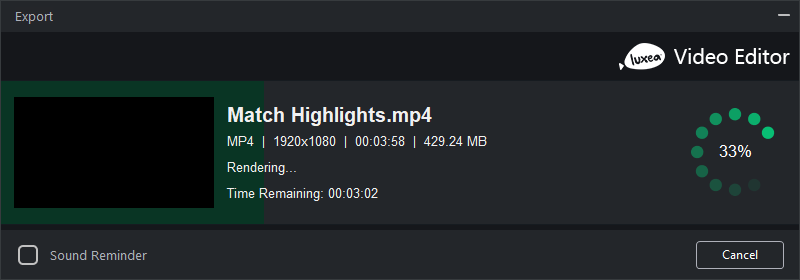Exporting to YouTube
The YouTube tab in the Export tool is used to craft media assets destined to be uploaded to YouTube.
The YouTube tab is divided into two sections: the left-hand "YouTube Sign-in" section and the right-hand "Options" section.
YouTube Sign-in Section
The YouTube Sign-in section contains the YouTube Sign In button. In order to successfully upload a completed project to YouTube, the sign-in procedure must be enacted.
- With media assets added to the Timeline, click the Export button located in the upper right-hand corner of the LUXEA Pro 7 interface.
- In the Export tool dialog's YouTube Sign-in section, click the Sign In button.
- Reply to all prompts until successfully logged into YouTube.

Options Section
The Options section is used to prepare a project's output for upload to YouTube.
To produce a YouTube output:
- With media assets added to the Timeline, click the Export button located in the upper right-hand corner of the LUXEA Pro 7 interface.
- In the Export tool dialog, select the YouTube tab and sign-in to YouTube (see To sign-in to YouTube).
- In the Options section, enter a name in the Title field.
- Enter a description in the Description field.
- Make a selection from the Category drop-down list. The Category field selection will determine how YouTube stores and presents the video to their viewers.
- Enter any relevant tags for the video into the Tags field. Use a comma to separate multiple values.
- Make a selection from the Privacy drop-down list. The Privacy field selection will determine how YouTube presents the video to their viewers. Selecting "Private" will restrict the video's availability to only the uploader. Selecting "Public" will allow the video to be presented to all of YouTube's viewers. Selecting "Unlisted" will allow the video to be viewable by all of YouTube's viewers with the link, but will not be listed on the site.
- Make a selection in the Share link on field. Enabling the Facebook checkbox will allow the video to be shared with Facebook (Facebook sign-in required). Enabling the X checkbox will allow the video to be shared with X (X sign-in required).
- Use the default value for the Save To field, or click the adjacent file folder icon to select a new location.
- Accept the default values for the Parameters field, or click the adjacent Settings button to set new size and rate parameters. For more information on the Settings button, see To set custom values for video quality.
- Click the Export button to upload the video to YouTube.
The Export dialog features a progress preview of the project and a Sound Reminder checkbox for sounding a reminder when rendering completes.

When uploading to YouTube, ensure that your YouTube Account has a Channel made for it, otherwise the Upload will fail. For more information on YouTube Channels, please visit YouTube.
To set custom values for video quality:
- Open the Export tool.
- Navigate to the Options section and click the Settings button adjacent to the Parameters field.
- In the resultant Settings dialog, enable one of the Normal, Better, or Best radio buttons.
- Under the Video heading, make selections for the Encoder, Resolution, Frame Rate, and Bitrate drop-down lists.
- Under the Audio heading, make selections for the Encoder, Channel, Sample Rate, and Bitrate drop-down lists.
- Click the OK button.
Video Parameters Options
| Field | Description |
|---|---|
|
Encoder |
Specifies the video data compression type. |
|
Resolution |
By default, the resolution will reflect the current settings of the Display Area Dimensions. To change the resolution, select a resolution from the drop-down, or select "Custom" from the drop-down list and specify new dimensions in the adjacent Width and Height fields. |
|
Frame Rate |
Determines the frequency of picture refreshes. |
|
Bitrate |
Select the bitrate to determine how much data will go to the screen per second of playback. A higher bitrate allows for a higher quality picture, however, it also increases the file size. |
Audio Parameters Options
| Field | Description |
|---|---|
|
Encoder |
Specifies the audio data compression type. |
|
Channel |
From the drop-down menu, select "Mono" to have the same sound produced from the left and right speakers, or, select "Stereo" to produce different sounds from the left and right speakers. |
|
Sample Rate |
Sampling describes the data rate of a sound recording. A higher sample rate allows for higher quality sound, however, it also increases the file size. |
|
Bitrate |
Determines how much audio data will go to the speakers per second of playback. A higher bitrate allows for a higher quality sound, however, it also increases the file size. |